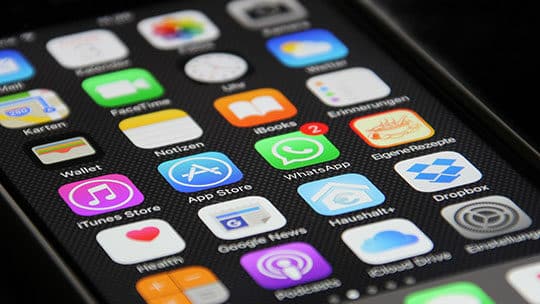Get ready to stay up-to-date with the latest trends in iOS app development! In this blog, we’ll dive into SwiftUI, Cloud Integration, AR/VR innovation, and App Security. We will also explore artificial intelligence and machine learning – their advantages as well as potential drawbacks – plus examples of how these powerful technologies are used by real apps out there.
With the ever-progressing tech world, mobile app developers must stay up to date with new tools and frameworks for iOS app development. This is paramount in order to craft apps that are useful, creative, and user-friendly – no matter your experience level! Knowledge of these developments will help you take advantage of cutting-edge technologies as they become available.
Discover what’s influencing the iOS app development world and how you can future-proof your skills with this enlightening blog. Get ready to stay one step ahead of the competition!
1. Artificial intelligence (AI) and machine learning (ML)

The development of computer systems that are capable of doing activities that traditionally require human intelligence, such as sensing, reasoning, and learning, is referred to as artificial intelligence (AI) and machine learning (ML). Data analysis, prediction, and repetitive work automation are all possible with AI and ML. and It plays an increasingly significant part in the creation of iOS apps, enabling developers to give users experiences that are more sophisticated and individualized.
Recommended for you: To learn more about incorporating AI and ML into your iOS apps, check out this blog on how to build an iOS app.
Importance of AI and ML in iOS app development
AI and ML have opened up a whole new world of possibilities for mobile app developers. With these technologies, apps can become much more efficient – from utilizing data to getting through complex tasks, providing users with personalized recommendations based on their history, or ultimately enhancing overall user experience. It’s no surprise that AI-driven capabilities are quickly becoming the building blocks for modern iOS applications around the globe!
Examples of AI and ML-based iOS apps
Siri, Uber, and Netflix are just a few examples of how iOS devices have been transformed by the integration of AI and ML. By harnessing these powerful technologies, users can benefit from advanced features such as personalized recommendations in their media consumption or even automated voice commands. This has revolutionized familiar experiences for millions around the world.
Siri provides personalized recommendations as well as allows users to play music, send messages, or book reservations with ease. Meanwhile, by forecasting riders’ demand, Uber is optimizing routes. Whereas Netflix suggests specialized TV shows or movies tailored for individual viewers – offering a truly unique user experience!
Challenges and considerations for using AI and ML in iOS app development
AI and ML are revolutionizing iOS app development, though not without their own unique set of challenges. Privacy and security should always be a top priority when dealing with sensitive user data that is collected or processed through AI/ML algorithms.
In addition, developers must ensure fairness in the algorithm’s outcomes; any existing biases can create further unequal opportunities for users if left unchecked. Lastly, the performance and resource requirements of these powerful technologies need to remain mindful as they can consume significant computing power.
2. SwiftUI

Apple debuted SwiftUI, a new framework for creating user interfaces in iOS apps, in 2019. SwiftUI offers developers a declarative vocabulary for creating UIs, making it simpler and more natural for them to construct complex, interactive user interfaces. SwiftUI also interfaces easily with other components of the Apple ecosystem, such as Xcode, allowing developers to create and debug their projects using familiar tools and processes.
Advantages of using SwiftUI for iOS app development
SwiftUI is transforming the way developers create iOS apps for their users, faster and better than ever. With its built-in support of UI elements like buttons, lists, and navigation as well as harnessing modern technology to ensure responsiveness across all platforms – SwiftUI offers an unparalleled user experience performance with streamlined development timescales.
Examples of apps built using SwiftUI
SwiftUI is used to develop a variety of apps, from basic day-to-day utilities to sophisticated data-driven programs – and even games like the addicting Anomoji! Those familiar with Apple’s iOS 13 will be aware that SwiftUI was employed in the revamp of its popular Reminders app. Talk about versatility!
Challenges and considerations for using SwiftUI in iOS app development
SwiftUI is a powerful new framework offering developers unique advantages to create iOS apps with ease, but there are some things to consider. SwiftUI still has room for growing and maturing compared to traditional UI development methods. It’s important that app creators evaluate their project requirements in order to weigh the benefits of using this cutting-edge technology against potential future limitations.
3. Cloud integration

Utilizing cloud integration allows mobile apps to offer enhanced performance and smoother user experiences. By connecting with the cloud, businesses can leverage valuable data storage capacity as well as access powerful computational capabilities on demand – helping them deliver an unparalleled digital experience for users of their applications.
Advantages of using cloud integration in iOS app development
For iOS app development, cloud integration helps create secure, accessible apps with the potential for limitless scalability. By using leading technologies such as big data, machine learning, and real-time analytics through cloud services, developers can enhance their products’ performance and efficiency – powering more powerful user experiences than ever before.
Examples of iOS apps that use cloud integration
iOS apps are taking advantage of cloud integration to increase user convenience and collaboration. The popular applications Dropbox, Slack, and Evernote all employ this technology in unique ways. From real-time messaging tools through Slack to file storage with Dropbox and note syncing via Evernote. These services make it easier than ever for users to stay connected on the go!
Challenges and considerations for using cloud integration in iOS app development
Cloud integration can provide convenient and powerful features for iOS app development. But there are considerations that must be taken into account. Security is of the utmost importance as cloud services may handle sensitive user data. Therefore, robust measures should be employed to ensure it remains secure.
Additionally, performance could potentially suffer if latency or other problems arise due to reliance on a remote service. Proper testing and optimizations should precede any deployment involving cloud resources in order to prevent issues before they start.
You may like: 9 Important Stages of Mobile App Development Life Cycle.
4. AR/VR

Technology is expanding our realities, introducing a new dimension of digital engagement. Augmented Reality (AR) and Virtual Reality (VR) bring the virtual world closer to us – bridging physical with digital experiences for greater immersion than ever before! VR provides complete intertwinement between user and environment, while AR augments the actual experience by layering in interactive information. These advancements are revolutionizing how we interact within this “mixed reality” space.
Advantages of using AR/VR in iOS app development
In our digital world, AR and VR are revolutionizing the way we interact with mobile apps and gadgets. Through AR, users can gain an in-depth understanding of their surroundings – think restaurant recommendations or shopping tips! Meanwhile, VR enables a captivating gaming experience like none other – pushing the boundaries between fantasy and reality.
Examples of AR/VR apps
With the vast possibilities of Augmented Reality and Virtual Reality, exciting applications are being created. From classic video games like “Pokemon Go” and “Minecraft Earth,” to innovative uses in education, real estate, and retail – AR/VR is revolutionizing how we interact with technology.
Challenges and considerations for using AR/VR in iOS app development
Unlocking the full potential of AR/VR for iOS app development requires a deep understanding of computer vision, graphics, and interaction design. Developers must also assess their project’s needs to decide if employing this complex technology is worth taking on. It should be noted that not all devices support these immersive experiences due to demanding hardware and software requirements – an essential limitation that developers need to keep in mind when evaluating its application capability.
5. App security

To ensure the most secure mobile experience, app security is an essential part of any successful digital strategy. From implementing measures to protect user data privacy and guard against malicious hacking attempts or unauthorized access to continuous monitoring for potential threats – a comprehensive approach ensures users have their sensitive information safeguarded at all times.
Advantages of using app security in iOS app development
Developing iOS has many advantages. But security must be taken into consideration. With an increase in malicious activities and cyberattacks, ensuring your applications are secure is more essential than ever – protecting both user data as well as the business’s reputation. Applying appropriate measures to maintain the safety of apps can help achieve peace of mind when developing on this platform.
Best practices for iOS app security
For iOS apps, developers should think carefully about security – from encrypting data to regularly patching vulnerabilities. It’s also important to thoroughly test the app prior to release and pay attention not just to what is developed in-house but any outside components that are utilized. By taking these precautions a secure environment for users can be established!
Challenges and considerations for iOS app security
Developing secure iOS apps requires a delicate balancing act between security, usability, and performance. Staying up-to-date on the latest threats means investing time and money into continuing education. To ensure optimal app safety for users it is essential to create multi-faceted strategies tailored to each application’s individual requirements.
6. IoT integration

Internet of Things (IoT) integration is revolutionizing the way we interact with physical objects. By connecting furniture, cars, and other everyday items to mobile devices, users can now control their surrounding environment from the convenience of a handheld device. Through cutting-edge IoT technology, data exchange between connected items has never been easier or more efficient!
Advantages of IoT integration in iOS app development
By integrating IoT into iOS app development, users can unlock the full potential of their devices. From monitoring and controlling connected technology right from your mobile device with ease to enhancing its usability and utility – user experience is improved like never before!
Examples of IoT integration in iOS apps
iOS apps have capitalized on the Internet of Things to provide users with a wide range of tools, from wearable technology and health & wellness aides to home automation. With just one tap in their mobile device, it’s now possible for people everywhere to take control over aspects like smart lighting and thermostat settings – transforming homes into intelligent hubs!
Challenges and considerations for IoT integration in iOS app development
Developing iOS apps with IoT integration offers many advantages. But careful consideration is required to meet the challenge. From varying levels of complexity and compatibility between devices to security risks that could compromise collected data. Developers must factor in these complexities when incorporating connected technologies into their projects. By taking appropriate precautions they can ensure a secure experience for both users and integrated devices alike.
You may also like: 15 Big Challenges in Mobile App Development You Need to Know.
Conclusion

As iOS app development continues to grow, it is becoming increasingly impacted by a wide range of fascinating developments that are propelling the industry forward. These include AI and ML integration, SwiftUI adoption, greater cloud connectivity, increased usage of AR and VR technology in apps, IoT integration for more connected experiences, as well as a heightened emphasis on security. All are interlinking together forming an exciting new future landscape for mobile platforms.
In the ever-evolving world of iOS app development, keeping up with industry trends is essential to staying ahead. By embracing these advancements you’ll unlock a wealth of opportunities for innovation and growth. Perfect if your goal is groundbreaking apps or simpler ones that are safe and user-friendly! Are you ready to increase those skills? Now’s the time; jump in!





